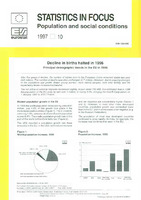| dc.contributor.author | Eurostat |
| dc.date.accessioned | 2020-09-28T04:57:32Z |
| dc.date.available | 2020-09-28T04:57:32Z |
| dc.date.issued | 1997 |
| dc.identifier.uri | https://ketlib.lib.unipi.gr/xmlui/handle/ket/2841 |
| dc.description | Downloaded from EU Bookshop. |
| dc.description | http://aei.pitt.edu/id/eprint/85145 |
| dc.description.abstract | After five years of decline, the number of babies born in the European Union remained stable last year (4.0 million). The number of deaths was also unchanged (3.7 million). However, due to ongoing changes in the population age profile (fewer young women, more elderly people), both total fertility and life expectancy levels increased somewhat. The net inflow of external migrants decreased slightly, to just under 730 000. It is estimated that in 1996 the population of the EU grew by well over 1 million, or nearly 0.3%, bringing the total EU population on 1 January 1997 to 373.7 million. |
| dc.format.extent | 4p. |
| dc.language.iso | en |
| dc.publisher | Social and regional statistics, and geographical information system |
| dc.subject | Household expenditure |
| dc.subject | Family Budgets |
| dc.subject | Family social security |
| dc.title | Statistics in Focus: Population and social conditions. HOUSING CONDITIONS IN THE EUROPE OF TWELVE IN 1994. |
| dc.type | working document |
| dc.publisher.place | Luxembourg |

